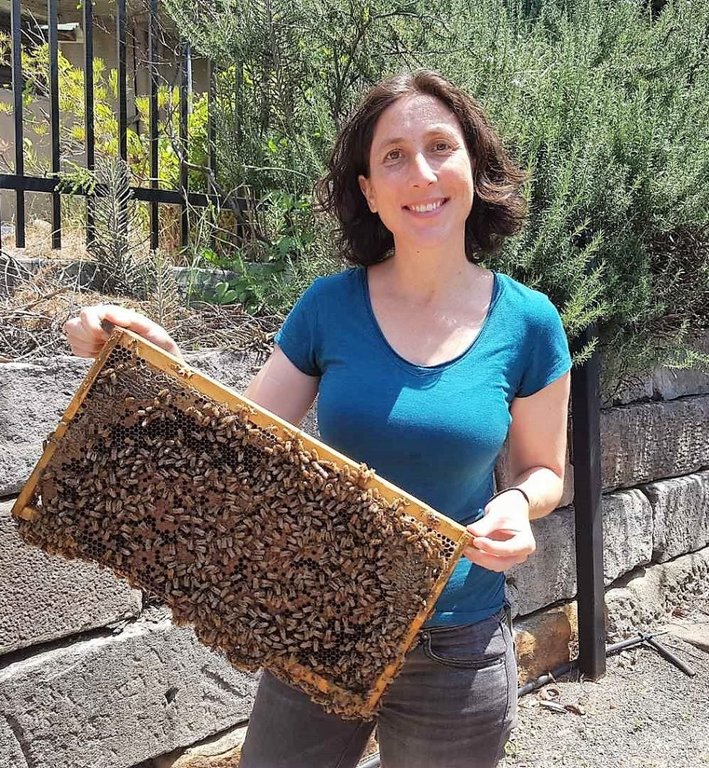In what is believed to be a first, scientists recently discovered a female honeybee that has two fathers but no mother. Sarah Aamidor, who published the findings in Biology Letters, spoke to us about her team’s observations and what they may mean.

Tell us about yourself and your research
I’m a third year PhD student in the Behaviour and Genetics of Social Insects lab at the University of Sydney. Among other interests, the lab focuses on the evolution of worker sterility in honeybees and the population genetics of bees. My PhD supervisor, Prof Ben Oldroyd, a former PhD student Dr Isobel Ronai, and Dr Boris Yagound, a post-doc in the lab, also co-authored the article.
I come from a molecular biology background and I’m interested in investigating the mechanisms that underlie reproduction and development using molecular tools. I’m particularly interested in how haplodiploidy (males haploid, females diploid) pre-disposes the evolution of unusual social systems in Hymenopteran (ants wasps and bees) insects.
What is your article about?
Honeybees are haplodiploid: females arise from fertilised eggs, while males arise from unfertilised eggs (and have no father). Gynandromorphs are sex mosaics that naturally occur at 1-2% frequency in occasional mutant beehives. Gynandromorph bees develop from two or more cell lines, each with a different genetic origin and different sex. So you can have a gynandromorph bee with a female left eye and a male right eye.
Previous work using genetic crosses and colour mutants determined that the most common kind of honeybee gynandromorph arises as a result of polyspermy, meaning that more than one sperm enters an egg. We investigated 11 gynandromorphs from a single colony using modern genetic markers. Our results show that most had 2-3 fathers and one mother, consistent with the polyspermy hypothesis, but one had no mother and two fathers, arising from the fusion of two sperm. Our results emphasize the flexible developmental possibilities that result from haplodiploidy. This flexibility engenders the evolution of some of the extraordinary social structures seen in some ants and bees.
What are the main points readers should take from the article?
The main take home message is the extent of the unusual and unexpected ways that sexual animals can fuse their genomes. In this paper, we demonstrated two hitherto unreported phenomena. First, we report a female bee that had two fathers created by the fusion of two sperms. Apart from the ‘wow!’ factor, this finding is notable since it shows that an insect embryo with two paternal genomes is viable. In mammals, bi-paternal individuals are not viable because of paternal-specific genomic imprints that must be balanced by maternal-specific imprints. Second, we found some individuals composed of three and even four parental origins (one mother and 2-3 fathers) that still gave rise to a viable adult bee. Just imagine that, a bee where different tissues are clonally descended from a different father.
Did anything surprise you while conducting your study, or from the reaction of the media?
Based on previous studies conducted in the 1960s, we expected to find individuals comprised of more than one father. But to find a bee that was seemingly a normal worker that had two fathers and no mother was completely unexpected. As for the media attention, we expected that our bi-paternal bee would peak some interest, but were very happy to see it ‘take off’!
Why did you submit to Biology Letters and how was your experience publishing with Royal Society Publishing?
We decided to submit to Biology Letters because of its multidisciplinary scope and its reputation for speedy publication times. We found the submission process straightforward and efficient, and the comments from the reviewers where constructive and provided insights as to how to improve the paper.
What’s next for you?
I would really like to explore the molecular and genetic bases of gynandromorphism but since gynandromorphs are hard to come by, I will switch my focus for the remainder of my PhD. I am currently investigating the molecular basis of how queen bees deactivate their ovaries (for example, in winter when they stop laying, or when they are caged for shipping through the post). Is it the same molecular pathway that makes worker bees sterile? I am also finalizing a paper about what happens when a thelytokous (female parthenogenesis) honeybee egg is fertilized. Amazingly, such eggs can develop as viable, triploid, females with two maternal and one paternal genome.
Find out more about submitting your own research to Biology Letters, or keep up to date with the latest journal content by signing up for table of contents alerts.




